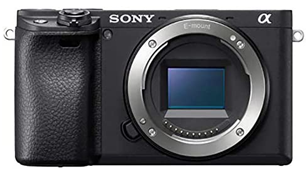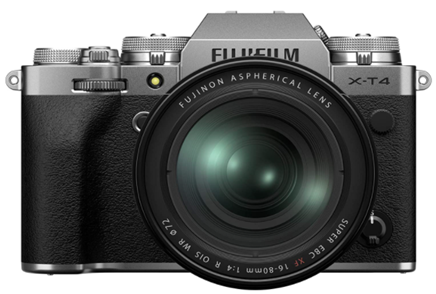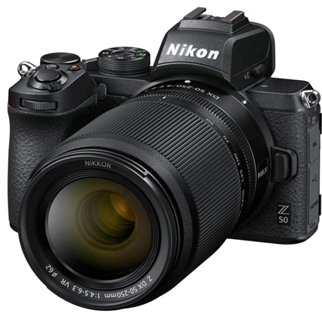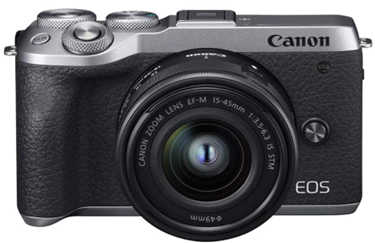This post compares the Fujifilm X -E4 vs Nikon Z50 vs Sony A6400 vs Canon EOS M6 Mark II, which are all mirrorless cameras targetting a similar customer base.
Also Read: List of the Best 1 inch Sensor Cameras
If you have been a die-hard fan of top-notch imaging solutions and checking out the excellent options for working with world-class cameras, it would always be a good idea to check out different camera options and weigh them against one another. We thought of comparing four of the popular cameras you would find quite interesting and appealing from that perspective.
We will go through a spec comparison and basic review of Fujifilm X-E, Nikon Z50, Sony A6400, and Canon EOS M6 Mark II.
Fujifilm X -E4 – An overview
The Fujifilm X -E4 belonged to the rangefinder-style mirrorless camera and was announced in January 2021. The camera features the same configuration offered on the previous generation X-T4 – few aspects being 26.1MP X-Trans CMOS 4 APS-C sensor and X-Processor 4. You can get access to a very richer color rendering and a wider dynamic range.
The ability to handle different lighting conditions should be one of the prime factors that should ideally go in its favor and provide you access to far greater performance enhancements. The camera also provides you access to an 8 fps continuous shooting with the mechanical shutter, 20 fps rate with an electronic shutter, or a 30 fps rate with an electronic shutter and a 1.25x crop, and it supports DCI/UHD 4K video recording at up to 30 fps and Full HD recording up to 240 fps. The ultra slow-motion playback offered by the camera should further make it one of the highly desirable products ever for recreating your imagination.
A few key specifications of the camera would include:
- 26MP APS-C sensor with X-Trans color filter array
- 3.0″ tilting touchscreen with 1.62M dots (can tilt up 180 degrees)
- 2.36M-dot electronic viewfinder, 0.62x magnification
- DCI 4K/30p, 4:2:0, 8-bit internal video recording (4:2:2 10-bit over HDMI out)
- Full HD video at up to 240p, for 10x slow motion
- 8 fps burst shooting with the mechanical shutter (20 fps with electronic)
- CIPA rated to 460 shots per charge (NP-W126S battery pack)
Pros
- A refreshing JPG image quality
- A stronger video performance that lets you shoot in full HD and 4K
- USB type C compatibility
- Great battery life
Cons
- No in-body stabilization
- Poor autofocus performance
In fact, the camera poses direct competition to the showstoppers such as Nikon Z50, the Sony a6400, and the Canon EOS M6 Mark II. Let us compare the Fujifilm X-E4 with the other three cameras and find which among them meet your needs.
Nikon Z50 – The Sneak Peek
The Nikon Z50 is indeed an excellent option for the best camera experience if you are trying to check out the best APS-C-based 20.9 MP camera. The device does come with the APS -C sensor with the Z mount. If you are not a professional photographer, you will find the Nikon Z50 one of the most reliable options for attracting new users.
The camera also comes with an optional bundle of two lenses for the sensor size, viz a 16-50mm F3.5-6.3 collapsible standard zoom and a 50-250mm F4.5-6.3 telephoto zoom. The built-in image stabilization should be another premium factor that would further make it one of the most reliable options ever. The image quality is quite a decent option for all your needs in terms of RAW performance and a great deal of JPG files. The high-end dynamic range offered by the camera should further make it one of the highly reliable options ever. It is indeed an impressive option for your needs in terms of a mid-price camera. The user interface and general aesthetics should be what would make it an extremely reliable camera ever.
Some of the specific parameters offered by the camera can include:
- 20.9MP CMOS sensor
- Twin control dial interface
- Up to 11 fps shooting with AE/AF, 5 fps with live view
- 4K video at up to 30p
- 2.36M-dot OLED viewfinder
- The rear touchscreen tilts up by 90° or down by 180°
- Single UHS-I SD card slot in the battery compartment
- Bluetooth-enabled Wi-Fi (via Snapbridge app)
- Creative Picture Control effects
Pros
- A perfect image and video quality
- A reliable dynamic range
- Rapid switching between stills and videos
- Simple WiFi image transfer.
Cons
- Autofocus may be erroneous at times
- Battery life may not be up to the mark
Sony A6400 – A Concise Review

The Sony A6400 is rated to be one of the excellent options for the best 24 MP camera. You can get access to an interchangeable lens with an APS-C sensor. The lightweight construction and easier documentation are a few of the factors that would make it one of the exciting choices ever for almost all your expectations. The camera does come equipped with the real-time tracking autofocus functionality that should further enhance your experience.
The new Bionz X processor powers the Sony A6400. That should ideally make it one of the highly reliable options for better autofocus and faster bootup functionality. The customizable My Menu functionality can prove to be yet another exciting option ever. In fact, the major strength of the Sony A6400 lies in the fact that it does provide you access to the best implementation of autofocus technology. A few other advantages that you stand to gain with the Sony A6400 include lack of overheating when shooting 4K video, a touchscreen that doubles up as a great option for selfie-and compatibility with every type of photography can further make it a great choice.
Some of the prime features offered by the Sony A6400 can include
- 24MP APS-C sensor
- 425-pt phase-detection AF system with Real-Time Tracking
- Tilting screen, 180° up, 90° down
- 2.36M-dot electronic viewfinder
- New Bionz X processor
- ISO range from 100-32000
- 11fps burst shooting (8fps with silent shutter)
- Interval shooting option added
- 4K/30p video capture
- Mic input, no headphone output
- 410 shots per battery charge (per CIPA)
- Wi-Fi with NFC and Bluetooth
Pros
- A leading autofocus functionality
- A great JPG and RAW image compatibility
- Water sealing capability
- A detailed 4K video, slow-mo 1080p
- The screen tilts up 180°, or down almost 90°
Cons
- Ergonomics leaves a lot to be desired
- Autofocus can be quite confusing
- Lack of in-body stabilization.
Canon EOS M6 Mark II – A unique review
Suppose you are checking out the best options offered by an extraordinary camera that tends to provide you access to a far higher degree of performance enhancement. The 32.5 MP mirrorless camera with the APS – C sensor should further make it one of the most reliable cameras and a better fit among the four cameras discussed here.
The Canon EOS M6 Mark II comes with a proprietary Dual Pixel design that should further enhance your experience. The Eye Autofocus capabilities offered by the Canon camera would further make it one of the highly reliable options for almost all the expectations that one may have. The 4K video recording provided by the Canon camera should be yet another worthy option for achieving a better degree of performance enhancement. It can shoot 4K at 30p or 25p, which should ideally make it one of the high-end options. The small kit performance offered by the camera should actually make it one of the reliable options ever for most of the experiences.
A few of the specifications offered by the camera can include
- 32.5MP Dual Pixel AF CMOS sensor
- 14 fps continuous shooting
- 30 fps Raw Burst mode (with AF Tracking and pre-shot buffering)
- UHD 4K video at 30p and 25p with no crop / full width
- 3.0″ rear touchscreen flips up by 180° or down by 45°
- Optional electronic viewfinder
- USB 2.0 port with Type-C connector
Pros
- Excellent image quality in terms of JPG and RAW
- A perfect direct control option
- A great burst speed performance
- Compact, yet feels quite great in your hands
- A simple user interface
Cons
- 4K videos do not have many details
- It needs a high power charger
- Eye detection autofocus
The Spec Comparison: Fujifilm X -E4 vs Nikon Z50 vs Sony A6400 vs Canon EOS M6 Mark II
Having understood the prime features offered by each of the cameras, here are the specifications offered by each of the cameras –
| Features | Fujifilm X-E4 | Canon EOS M6 Mark II | ||
| Lens Mount | FUJIFILM X | Nikon Z | Sony E | Canon EF-M |
| Camera Format | APS-C (1.5x Crop Factor) | APS-C (1.5x Crop Factor) | APS-C (1.5x Crop Factor) | APS-C (1.6x Crop Factor) |
| Sensor Resolution | Effective: 26.1 Megapixel (6240 x 4160) | Actual: 21.51 Megapixel Effective: 20.9 Megapixel (5568 x 3712) | Actual: 25 Megapixel Effective: 24.2 Megapixel (6000 x 4000) | Actual: 34.4 Megapixel Effective: 32.5 Megapixel (6960 x 4640) |
| Aspect ratio | 1:1, 3:2, 16:9 | 1:1, 3:2, 16:9 | 3:2, 16:9 | 1:1, 3:2, 4:3, 16:9 |
| Sensor Size | 23.5 x 15.6 mm | 23.5 x 15.7 mm | 23.5 x 15.6 mm | 22.3 x 14.9 mm |
| Image file format | JPEG, Raw | JPEG, Raw | JPEG, Raw | JPEG, Raw |
| Image stabilization | No | Digital (for videos) | No | Digital (for videos) |
| ISO range | Auto, 160 to 12800 (Extended: 80 to 51200) | Auto, 100 to 51200 (Extended: 100 to 204800) | 100 to 32000 (Extended: 100 to 102400) | Auto, 100 to 25600 (Extended: 100 to 51200) |
| Shutter speed | Mechanical Shutter 1/4000 to 3600 Seconds 1/4000 to 4 Seconds in Program Mode 1/4000 to 30 Seconds in Aperture Priority Mode 0 to 60 Minutes in Bulb Mode Electronic Shutter 1/32000 to 900 Seconds 1/32000 to 4 Seconds in Program Mode 1/32000 to 30 Seconds in Aperture Priority Mode | Electronic Front Curtain Shutter 1/4000 to 30 Second Bulb Mode Time Mode Electronic Shutter 1/4000 to 30 Second Bulb Mode Time Mod | Electronic Front Curtain Shutter 1/4000 to 30 Seconds Bulb Mode | Mechanical Shutter 1/4000 to 30 Second Bulb Mode Electronic Shutter 1/16000 to 30 Second |
| Exposure Modes | Aperture Priority, Manual, Program, Shutter Priority | Aperture Priority, Manual, Program, Shutter Priority | Aperture Priority, Auto, Manual, Program, Shutter Priority | Aperture Priority, Manual, Program, Shutter Priority |
| Continuous shooting | Mechanical Shutter Up to 8 fps at 26.1 MP for up to 105 Frames (JPEG) / 18 Frames (Raw) Up to 5 fps at 26.1 MP for up to 458 Frames (JPEG) / 24 Frames (Raw) Up to 4 fps at 26.1 MP for Unlimited Frames (JPEG) / 28 Frames (Raw) Up to 3 fps at 26.1 MP for Unlimited Frames (JPEG) / 34 Frames (Raw) Electronic Shutter Up to 20 fps at 26.1 MP for up to 32 Frames (JPEG) / 17 Frames (Raw) Up to 10 fps at 26.1 MP for up to 81 Frames (JPEG) / 18 Frames (Raw) Electronic Shutter Up to 30 fps at 16.6 MP for up to 29 Frames (JPEG) / 17 Frames (Raw) Up to 20 fps at 16.6 MP for up to 79 Frames (JPEG) / 17 Frames (Raw) Up to 10 fps at 16.6 MP for up to 153 Frames (JPEG) / 18 Frames (Raw) | Up to 11 fps at 20.9 MP Up to 5 fps at 20.9 MP Up to 4 fps at 20.9 MP Up to 30 fps at 8 MP | Up to 11 fps at 24.2 MP for up to 46 Frames (Raw) / 116 Frames | Up to 14 fps at 32.5 MP for up to 23 Frames (Raw) / 54 Frames (JPEG) Up to 30 fps at 18 MP |
| Focus Mode | Auto and Manual Focus | Auto and Manual Focus | Auto and Manual Focus | Auto and Manual Focus |
| Focus Mode | Continuous-Servo AF (C), Manual Focus (M), Single-Servo AF (S) | Automatic (A), Continuous-Servo AF (C), Full-time Servo (F), Manual Focus (M), Single-Servo AF (S) | Automatic (A), Continuous-Servo AF (C), Direct Manual Focus (DMF), Manual Focus (M), Single-Servo AF (S) | Continuous-Servo AF (C), Manual Focus (M), Single-Servo AF (S) |
| Autofocus points | Phase Detection: 425 | Phase Detection: 209 | Phase Detection: 425 Contrast Detection: 425 | Phase Detection: 5481 |
| Wireless connectivity | Bluetooth Wi-Fi | Bluetooth Wi-Fi | WiFi | Bluetooth Wi-Fi |
| Connectivity | USB Type-C (USB 3.2 Gen 1), HDMI D (Micro), 3.5mm Microphone | USB Micro-B (USB 2.0), HDMI D (Micro), 3.5mm Microphone | 3.5mm Microphone, HDMI D (Micro), Wired Remote Port, USB Micro-B (USB 2.0) | USB Type-C (USB 2.0), HDMI D (Micro), 3.5mm Microphone |
The Concluding Thoughts
Well, that was a complete comparison for the best experience you can gather for your needs in an enhanced experience in enjoying the best imaging ever. Comparing the best four competing cameras should ideally help you get access to a very advanced performance ever. The spec comparison shared here should ideally help you get access to a far more advanced performance ever.
Check out those specifications and get access to a great degree of performance as per your preferences.





